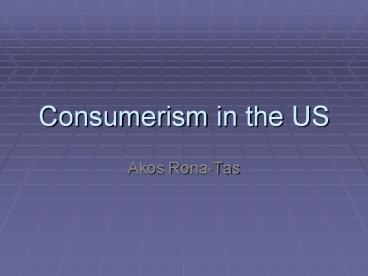Consumerism in the US - PowerPoint PPT Presentation
Title:
Consumerism in the US
Description:
Consumerism in the US Akos Rona-Tas The Second Wave of Consumerism 1945-1975 Post-WWII boom Growing productivity, rising incomes 1960s Women enter the labor force ... – PowerPoint PPT presentation
Number of Views:447
Avg rating:3.0/5.0
Title: Consumerism in the US
1
Consumerism in the US
- Akos Rona-Tas
2
History of Consumerism
- Central Paradox
- How did the Puritan tradition of thrift and
asceticism turn into a culture of spending and
materialism? - It happened in three waves
3
The First Wave of Consumerism (1910s-1920s)
- Mass production
- Consumer durables appear in the household
- Electricity
- Invented electric washing machine and vacuum
cleaner(1903), Fords Model T (1908),
refrigerator (1913 see above) - Mass Marketing
- The department store (Wannamaker, Marshall
Fields, Woolworth, Sears etc.) - Creation of consumer credit
- Usury, pawnshops and borax houses (stores selling
cheap goods on installment) - A.P. Giannini (Bank of Italy (1904) ? Bank of
America) - 1906 San Francisco earthquake
- Charga-plate 1920s
- Great Depression 1929-1941
4
The Second Wave of Consumerism1945-1975
- Post-WWII boom
- Growing productivity, rising incomes
- 1960s Women enter the labor force
- Competitive consumption
- Income and desires are still connected
- Keeping up with the Joneses (your neighbors)
- Consumer credit
- Diners Club Card (1950), Bank of America Card
(1958, 1976 renamed Visa)
5
Home ownership grew
6
The housing bubble
7
Third Wave of Consumerismmid 1970s -- 2008
- No increase in leisure
- Increasing Inequalities
- Conspicuous spending at the top
- Mass Media
- Growing expectations
- Advertisement, television shows
- Credit
- New tools for spending
- New forms of consumer credit, over-indebtedness
- Disconnect between incomes and desires
- The aspiration gap -- keeping up with the
Gateses
8
Consumer debt on the rise
9
Both mortgage and consumer debt rose
substantially in the last decade
10
People have saved less and less
11
Growing income did not result in more happiness
- Income and Happiness in the US from 1945-2000
(Layard 2005).































